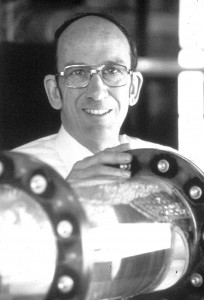History

The C. Maxwell Stanley Hydraulics Laboratory as seen across Riverside Drive.IIHR—Hydroscience & Engineering, a unit of The University of Iowa’s College of Engineering, is one of the nation’s leading fluids-related research and engineering laboratories. Founded in 1920, it is also one of the nation’s most historically significant.
Situated on the Iowa River in Iowa City, Iowa, IIHR seeks to be a leader in hydroscience and engineering research, and to educate students to be future leaders in these areas. The education IIHR provides in the theoretical and computational aspects of fluid flow, combined with hands-on engineering practice, attracts a vibrant international mix of students with a rich variety of interests.
Research activities, funded by grants, agreements, and contracts with a variety of private organizations and governmental agencies, extend well beyond the Midwest into the international domain.
Modest Beginnings
Today’s complex efforts had simple beginnings. In 1920, a small brick cubicle above a flume next to the Iowa River became the first hydraulics laboratory at the University of Iowa. This laboratory provided the setting for Iowa’s first research and classes in hydraulics.
The laboratory’s first researcher and director, Floyd Nagler, vigorously developed a program of river surveys and small-scale hydraulic modeling. To more firmly establish and broaden the research program, Nagler formally founded IIHR (Iowa Institute of Hydraulic Research) in 1931. By 1932, he had overseen the building of the present hydraulics laboratory structure, which boasted more than 50 times as much floor space as the original laboratory.
Industry and Defense
IIHR’s hydraulic modeling efforts in the 1930s were instrumental in planning the current nine-foot navigation channel of the Upper Mississippi River with its locks and dams. In the early 1940s, attention was transferred to the war effort. IIHR researchers became key players in several U.S. defense efforts, including the development of nozzles for fighting fires at sea, the discovery of methods to disperse fog over British landing fields, investigations of cavitation around torpedo heads, and IIHR’s first studies in ship hydrodynamics.
Fundamental Fluid Mechanics
For two decades following the war, IIHR’s energies flowed toward basic fluid mechanics and away from applied hydraulic studies. These efforts were propelled forward by IIHR Director Hunter Rouse, who was one of the first in the United States to write texts and teach courses on fundamental fluid mechanics for hydraulic engineers. His efforts helped establish IIHR as one of the world’s leading educational and research laboratories. Among his many accomplishments, Rouse created a series of teaching films on hydraulics that is still used today.
New Initiatives
The 1960s brought a new director (John F. Kennedy) and new directions. IIHR once again embraced applied studies. Grants and industrial contracts sparked several new initiatives, such as studies in the environmental effects of hydraulic structures and water pollutants. Increasing
emphasis on model studies and a diversification of the research program led to the construction of multiple laboratory annexes, each fitted with sophisticated flow-diagnostics equipment.
IIHR Today
New leaders (V.C. Patel and current IIHR Director Larry Weber) have encouraged IIHR’s further development, incorporating the strengths of the past into an expanding and complex mix of research, education, and public service. Today’s blend of applied and theoretical studies, both of which have been enriched by computerized collection and analysis of data and by numerical modeling techniques, has set the stage for a great diversity of projects ranging from model studies of specific hydraulic structures to computational fluid dynamics investigations of complex flow mechanisms.
The floods of 2008, which hit the University of Iowa campus hard, brought about the creation of IIHR’s Iowa Flood Center, the nation’s first academic center devoted to the study and research of floods. State appropriations, in combination with various grants and contracts, support IFC’s efforts to improve flood monitoring and prediction capabilities in Iowa.
Another initiative, the Clear Creek Digital Watershed, takes advantage of recent advances in computer technology to connect real-time sensor networks, online data repositories, communication networks, advanced analytical and modeling tools, and powerful computing engines into a single digital framework.
In the area of ship hydrodynamics, IIHR researchers can now conduct tests on captive or radio-controlled model-scale navy ships under a variety of real life conditions at the new $4.9 million wave basin facility. The wave basin provides an enhanced experimental component for IIHR’s combination of simulation-based design and model-scale experiments.
After more than nine decades of innovation, IIHR—Hydroscience & Engineering continues to reinvent itself for an ever-changing world, with a flourishing and expanding network of people, techniques, research initiatives, and fields.

IIHR's state-of-the-art wave basin facility for Ship Hydrodynamics research was completed in late 2010.
IIHR’s long and distinguished has been told through in-house publications since the 1930s, and is also the topic of the 1998 book Flowing Through Time: A History of the Iowa Institute of Hydraulic Research. Visitors to IIHR are encouraged to study the three historical displays on the Stanley Hydraulics Lab’s first floor, and to visit the IIHR Archives on fourth floor. Because of its contributions to water’s study and use, the American Society of Civil Engineers recognized SHL as a National Historic Civil Engineering Landmark in 2005, because of the breadth, duration, and significance of the research and education performed here. This award states that the SHL is the oldest university-based hydraulics laboratory in the nation continuously focusing on research and education in hydraulic engineering. Also, the American Water Works Association designated IIHR as an American Water Landmark.
For more about IIHR history, visit:
- Archives
- Flowing Through Time
- Historical Displays
- History of IIHR (PDF—PowerPoint presentation)
- History Resources
- Hunter Rouse Films
- IIHR History-Related Publications (including publications on the history of IIHR)
- Rare Book Collection
- Teaching of Fluid Mechanics at IIHR







